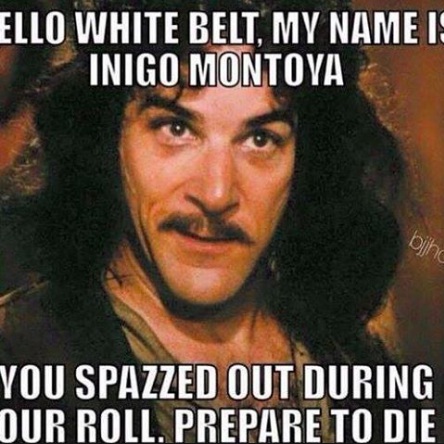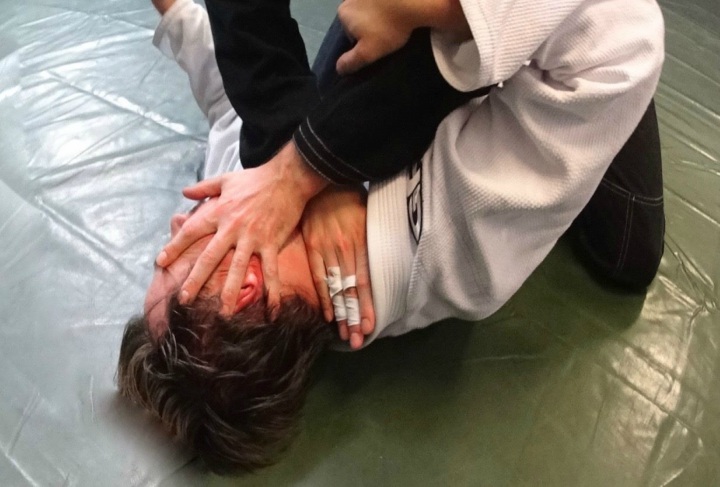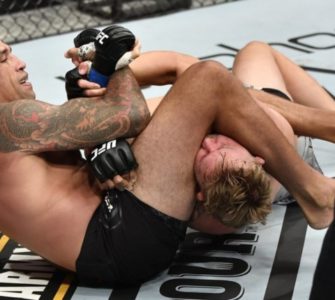Guest post by Masafumi Matsumoto, a BJJ black belt from Japan who has been travelling the world, training, competing and working as a translator. ‘Masa’ is known for having a very good guard, especially his spider guard.
You know him.
Jumping around even if it doesn’t quite make sense to do so.
Accidentally punching you in the face from time to time.
Rolling as if it’s a matter of life and death.
He’s not a bad guy for sure.
He might be actually pretty decent as a blue belt.
But he just can’t help it.
His spaz nature is real.
If you’re a white or blue belt, and have ever wondered what to do with your ultra aggressive blue belt training partner, this article is for you.
(I assume purple, brown, and black belts have figured it out and have your own preferred way to deal with such ultra aggressive blue belts.)
My advice to you is very, very simple: Stay safe, slow him down, and use sparring with him as an opportunity to practice specific techniques/positions.
Stay Safe
If you enjoy training and you do train as much as you can, it’s likely that you will get better as much as you train. But, if you get injured and your injury stops you from training, that will be a real bummer.
Sure, your ultra aggressive training partner should realize that he might be putting people into dangerous situations by being spazzy, and your instructor/s may need to tell him to slow down if it’s really bad, but there are things you can do on your side as well.
Now, first thing. Remember, it’s OK to tap. “Wait, you offered a piece of advice on how to neutralize the ultra aggressive blue belt, and the first thing you suggest is to tap?”
Yes! And do tap hard, and tap as many times as you need to. It’s much better than getting injured.
Think about it. Which one would you prefer–getting injured and unable to train for a month or two (or more), or tapping as many times you need to while being able to show up at every training session?
I believe it’s an obvious choice.

Another thing is this.
It can be tempting to match your own aggressiveness with your training partner’s… but, you don’t need to. You don’t need to move as quickly as your ultra aggressive partner. When you lose your own control, that can lead you to a greater chance of an unnecessary and avoidable injury.
And instead of speeding up your own moves, you can slow your opponent down. Consider that option.
But how? You may ask.
This leads us to the next piece of advice …
Slow Him Down
Roughly speaking, there are two ways to slow him down.
Make him tired.
Put him into a position where he cannot move as much as he wishes.
These ideas are pretty straightforward, I believe. And if you’re wondering what exactly you can do, here are some suggestions.
Spider guard
I love using spider guard, and I’m definitely biased about this option. But, it’s a great way to make your opponent run around and manipulate him like a puppet. He will be spending all the energy he has while trying to pass your guard (if you can keep the guard, that is). Once he’s tired and less aggressive, you can start working on your own game.
X guard
If you feel that spider guard is not for you because of your body type, playing x guard may be a good one for you. X guard immobilizes your opponent well, and it’s hard to pass, while giving you a variety of options. And it’s not so dependent on your body type either. You may not be able to make your opponent run around like with spider guard, but it’s definitely an option to consider.
Half guard/deep half guard/closed guard
These guards are great for immobilizing your opponent. Again, it may not be as tiring as spider guard, but in terms of slowing down your opponent by putting him into a hard-to-move position, these guards give you great options to consider.
What about guard passing?
When you think of making your opponent tired, you might think of speed-based passing. Sure, it can make the guard player tired, but as someone who has decent guard skills, in all honesty, dealing with pressure based passing is more tiring.
And provided that we’re talking about dealing with your ultra aggressive blue belt training partner, with the focus on slowing him down… my suggestion is to look into pressure passing instead of speed-based passing in this particular context.
If you want to get some ideas about how to do pressure-based guard passing, watch how Bernard Faria and Murilo Santana (for heavy weight players) as well as Gui Mendes and Lucas Lepri (for lighter players) fight, for example.
So far so good?
OK, let’s finish this with the third piece of advice… (I’ll make it nice and brief.)
Use Sparring With Him As An Opportunity To Practice Specific Positions
This is a mindset you can have while sparring with your ultra aggressive blue belt training partner.
I understand you might feel a bit intimidated and worried about getting injured. It’s perfectly fine. I feel the same way too. I don’t want to get injured.
But, it shouldn’t stop you from rolling with him.
You can still use that mat time to improve your game.
You can practice the guards I mentioned above. You can practice pressure-based passing.
Or even if you feel you’re not yet able to go for a sweep or pass from these positions, you can still practice keeping your position and staying safe.
Turn everything into opportunities to improve your game, and your game will improve for sure.
And when you get better, you may be able to handle ultra aggressive training partners with clean techniques at ease.
Until then… stay safe, slow him down, and use sparring with him as an opportunity to practice specific positions.
Bruno Malfacine Is The Greatest BJJ Competitor Ever To Step On The Mat & For The First Time Ever – The Only 10x Weight Class Black Belt World Champion In History – Wants To Show You How He Wrecks The Big Guys.
- Learn The Secrets That Have Allowed This 127-LB Champion To Destroy & Dominate 200+ LB Monsters At-Will.


















